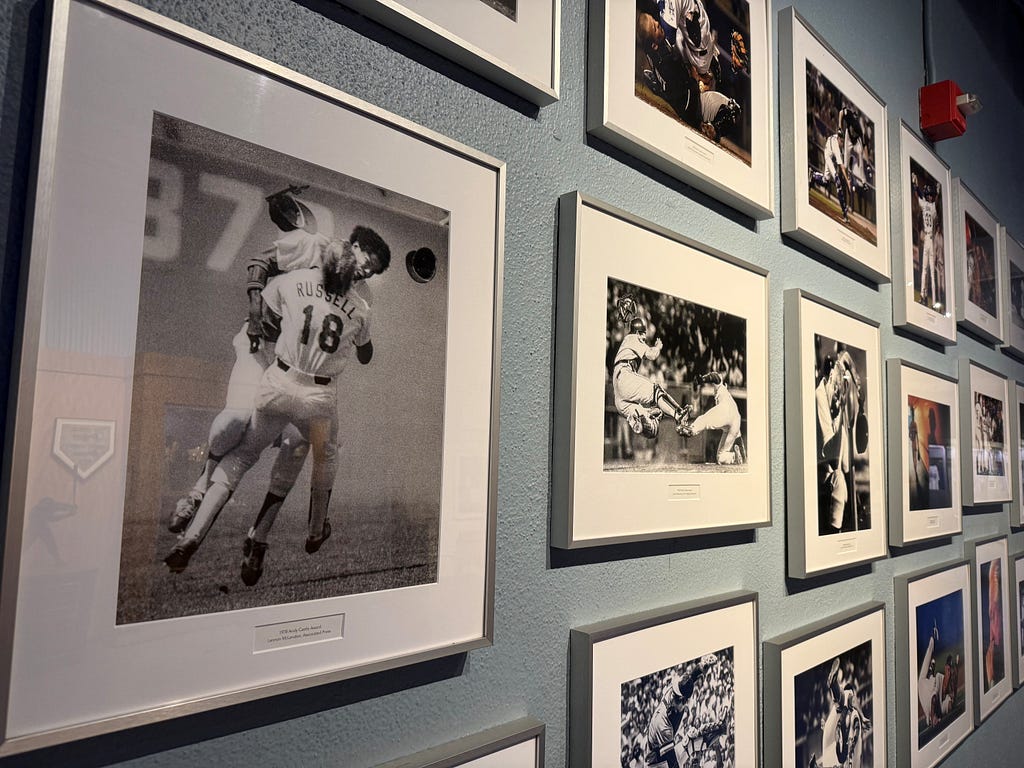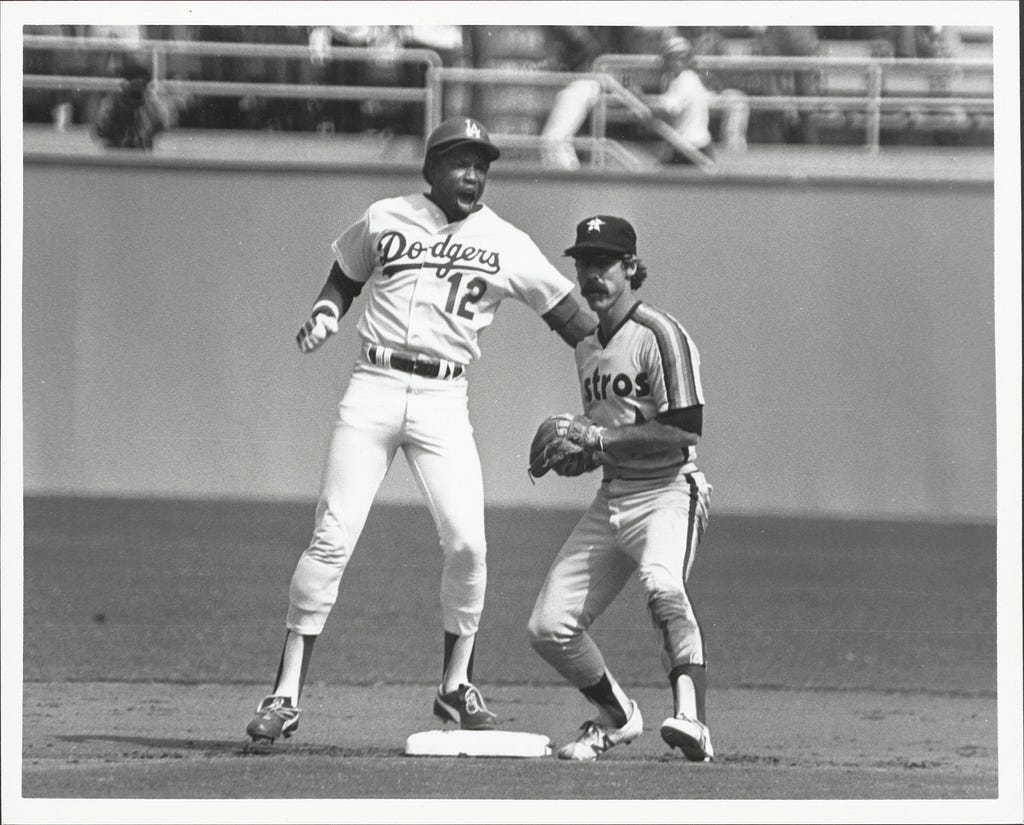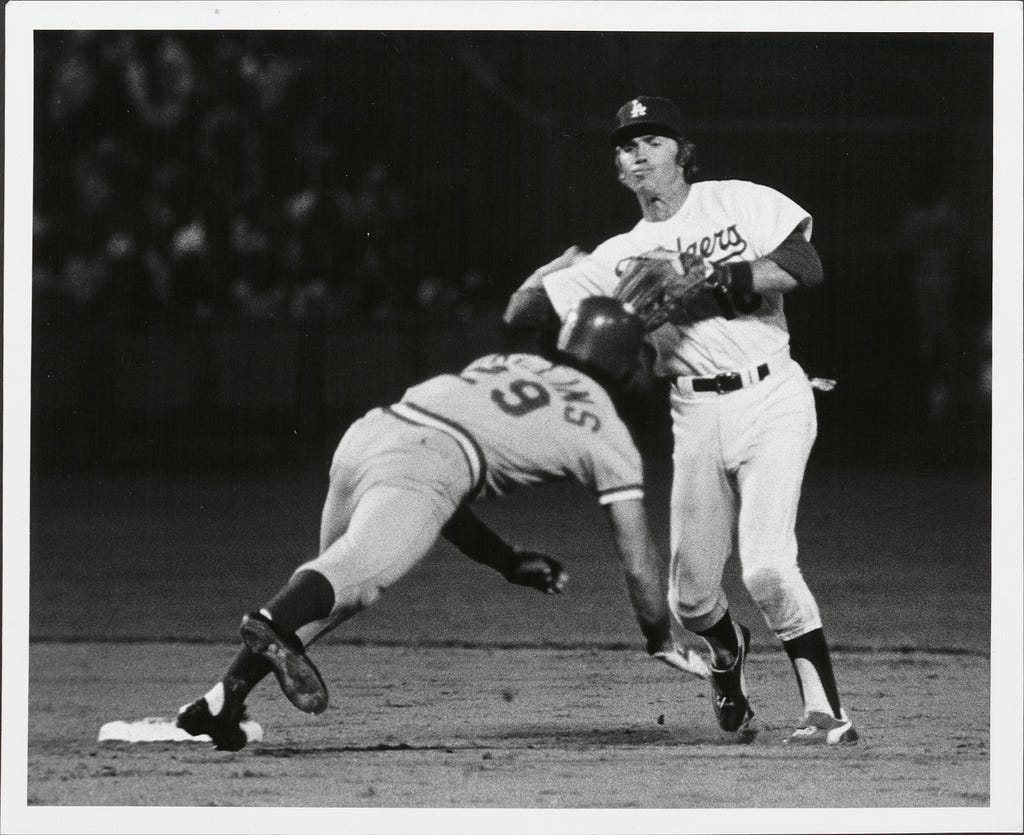
by Mark Langill
Outside the press box at Dodger Stadium, a framed gallery of award-winning photos by Los Angeles area photographers includes a 1978 grainy image of a left fielder and a shortstop violently crashing into one another on a sunny Sunday afternoon while intently chasing a bloop hit by the game’s leadoff hitter.
Although both players initially lay motionless on the field, they eventually recovered with no serious injuries.
The photo by Lennon McLendon of the Associated Press captured a rare moment when the respective worlds of Dusty Baker and Bill Russell collided.
They were teammates for eight seasons after Baker’s trade from the Atlanta Braves to the Dodgers before the 1976 season. They played in three World Series together, including 1977 and 1978, when Los Angeles had to get past the Philadelphia Phillies in the National League Championship Series. Each of those best-of-five series went to four games.
Baker and Russell were a classic case of contrasting personalities blending into valuable role players as the Dodgers spent most of the 1970s battling the Cincinnati Reds in the NL West. In an era before the Wild Card, the division’s runner-up team went home.
Baker, who grew up in Riverside, wore uniform №12 in honor of two-time National League batting champion Tommy Davis, one of his boyhood idols.
When Baker arrived in Los Angeles, he became an instant fan favorite. He wore wristbands on his arm and sported a toothpick in his mouth. No matter the level of his batting average, Baker always had a smile or a wave for his supporters. The patrons in the Left and Right Field Pavilions tossed packs of bubble gum to the effusive player with a cool nickname. Soon, they coined the area “Bakers-field.”

Russell, by contrast, didn’t mind blending into the background of his higher-profile teammates. He could give the deadpan stare without breaking character.
Before his Major League debut at age 20 in 1969, Russell never visited a Major League ballpark. He grew up in Pittsburg, Kansas (“no H,” Russell says) with a population of 18,000 and change.
While Baker was among the vocal leaders in the Dodger clubhouse, Russell was the quiet agitator, ready with a one-liner to utter under his breath.
Russell, who played a Los Angeles franchise-record 2,181 games through 1986, had a range of teammates from veterans like Don Drysdale and Wes Parker in his early Dodger years to prospects such as Orel Hershiser and Steve Sax. And like the modern-day Mookie Betts, Russell made the transition from the outfield during his career, learning how to play shortstop at the Major League level.
Baker won 1977 NLCS MVP honors when he batted .357 against the Phillies, including a grand slam during a 7–1 win in Game 2 that evened the series at one game apiece heading back to Philadelphia. Russell’s go-ahead single in Game 3 through the legs of reliever Gene Garber capped a miraculous comeback that turned a 5–3 deficit in the top of the ninth inning into an eventual 6–5 victory.
In 1978, the Dodgers won the first two games of the NLCS in Philadelphia. The Phillies won Game 3, 9–4, in a matchup of two future Hall of Famers: Don Sutton and Philadelphia’s Steve Carlton.
An all-or-nothing fifth game loomed on the horizon when the teams went into extra innings in Game 4, tied 3–3.
The Dodgers mounted a rally in the bottom of the 10th that began when Ron Cey drew a two-out walk from reliever Tug McGraw. Baker smoked a sinking line drive to center field that went off the glove of a charging Garry Maddox. The error was stunning as Maddox won seven consecutive Gold Glove Awards from 1976 to 1982.
Russell followed.
On a 1–0 pitch, he lined a single to center. The ball bounded twice in front of Maddox, who watched helplessly as Cey charged toward home plate with the winning run.

2025 NLDS: When Baker and Russell won the battle with the Phillies was originally published in Dodger Insider on Medium, where people are continuing the conversation by highlighting and responding to this story.
